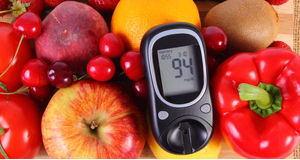Diabetes Management
Diabetes and Skin problems: Keep Them at Bay
5 min read
By Apollo 24/7, Published on - 04 December 2020, Updated on - 29 August 2024
Share this article
0
0 like

What skin problems can be experienced by people with diabetes?
Darkening of skin: Medically called acanthosis nigricans, darkening and thickening of the skin of the neck, armpits, and groin area is a problem commonly seen in diabetics. The skin may also appear raised and dark tan in colour.
Painless patches on the skin: Diabetes can affect the blood supply to the skin resulting in skin condition such as diabetic dermopathy, which appears as painless scaly light brown-red coloured patches usually seen on the front of the legs.
Stiffening of digits: People with diabetes may experience thickening of the skin on their digits, that is the toes, fingers, and hands, which is medically called digital sclerosis. This condition can make the fingers stiff, thick, waxy and difficult to move. It can also be seen on the forearms, upper arms, upper back, shoulders, and neck.
Stiffening of neck and back: This condition looks similar to digital sclerosis as the person experiences thickening of the skin. However, the thickening is seen mostly on the back of the neck and upper back and is mostly seen in overweight people with diabetes.
Red-brown bumps on the skin: This condition is medically called Necrobiosis Lipoidica Diabeticorum, which occurs due to changes in the blood vessels and appears as reddish-brown coloured bumps that turn patchy. The patches can be shiny (wax-like shine) painful and itchy.
Rashes: People with diabetes may witness ring or arc-shaped rashes on the fingers, hands, and feet, which is medically called disseminated granuloma annulare. These rashes may appear red, red-brown, or skin-coloured.
Firm yellow bumps on the skin: People with high blood glucose and triglycerides (type of cholesterol) levels may experience firm, yellow, pea-sized bumps on the skin which can be itchy and surrounded by red halos. This is medically called eruptive xanthomatosis and is usually seen on the feet, arms, legs, buttocks, and the backs of the hands.
Dry and itchy skin: Dry and itchy skin (pruritus) in diabetics can be a sign of a yeast infection or poor blood flow. Mostly, the itching is experienced in the lower legs and feet but can be experienced on any other parts of the body as well.
Blisters: Diabetic blisters can resemble burn blisters and are usually seen on the fingers, hands, feet, legs and forearms. These blisters are usually painless, large in size and heal on their own without leaving a scar. These blisters can be a sign of diabetic neuropathy (nerve pain).
Because of any reason, if you or your family member have any of the above mentioned skin conditions, consult our best dermatologists.
How can people with diabetes take better care of their skin?
Follow the diet, exercise regime and medications as per the advice of the healthcare provider.
Drink plenty of water as it would help in keeping the skin moist and hydrated.
Use a mild, moisture-containing soap for bathing and pat dry the body properly as wet skin can act as a site of infection. Do not use products that contain fragrance or dye.
Thoroughly clean places like underarms, under the breasts, between the legs and between the toes as water can get collected easily in these areas.
Avoid bubble baths and extremely hot water as it can dry out the skin.
Apply moisturizer on the entire body after bathing to lock the moisture in. Avoid chapped lips by moisturizing with a lip balm.
Use a humidifier to add moisture to the room, thus preventing drying of the skin.
Use a sunscreen with an SPF of or higher than 30 to protect the skin from harmful UV rays.
Try wearing cotton undergarments as they allow the skin to breathe through it.
Treat all the wounds and cuts right away using antibacterial ointments, gauze pads, hypoallergenic tape and cleansing wipes. Avoid using iodine and alcohol to clean the cuts as they can be too harsh.
Even after following all these precautionary measures and home remedies, if you have skin problems and abnormal blood glucose levels, consult with our highly experienced diabetologists and dermatologists.
When to seek medical help?
- A rash or infection after taking medication or near the site of insulin injection
- A blister, cut or burn that persists for long
- Persistent dry skin
- Pain and discomfort which lasts for more than 2 days
- Persistent fever
- Formation of pus around a wound or a sore
Takeaway
You can also try the Apollo 24|7 Diabetes Self-Management Tool to log your sugar values, track patterns, know all about food nutrition and more.
Diabetes Management
Consult Top Diabetologists
View AllLeave Comment
Recommended for you
.jpg?tr=q-80)
Diabetes Management
Timing Your Exercise: A Key to Better Sugar Control
The timing of your exercise can significantly impact blood sugar control. While morning workouts may cause temporary spikes in blood glucose levels, evening exercises offer enhanced benefits. However, always consult your healthcare provider for a personalized workout schedule. Monitor your blood sugar levels before and after a workout to avoid potential dangers.
.jpg?tr=q-80)
Diabetes Management
Dietary Recommendations For Diabetic Athletes
Diabetes management for athletes requires a balanced intake of macronutrients, strategic meal timing, adequate hydration, and frequent blood glucose monitoring. The Apollo Super 6 program can provide personalized support and valuable resources that cater to your unique needs. With the right dietary guidance and consistent effort, being a diabetic athlete is not just achievable but also rewarding.

Diabetes Management
Diabetes and Alzheimer's: How are They Connected?
Current research shows a significant connection between diabetes and Alzheimer's. The common thread? Blood sugar control. Poorly managed diabetes can increase the risk of cognitive decline and Alzheimer's disease. Understanding this link could provide strategies to manage both conditions effectively.
Subscribe
Sign up for our free Health Library Daily Newsletter
Get doctor-approved health tips, news, and more.
Visual Stories

8 Fruits That are Incredibly Healthy for Diabetes
Tap to continue exploring
Recommended for you
.jpg?tr=q-80)
Diabetes Management
Timing Your Exercise: A Key to Better Sugar Control
The timing of your exercise can significantly impact blood sugar control. While morning workouts may cause temporary spikes in blood glucose levels, evening exercises offer enhanced benefits. However, always consult your healthcare provider for a personalized workout schedule. Monitor your blood sugar levels before and after a workout to avoid potential dangers.
.jpg?tr=q-80)
Diabetes Management
Dietary Recommendations For Diabetic Athletes
Diabetes management for athletes requires a balanced intake of macronutrients, strategic meal timing, adequate hydration, and frequent blood glucose monitoring. The Apollo Super 6 program can provide personalized support and valuable resources that cater to your unique needs. With the right dietary guidance and consistent effort, being a diabetic athlete is not just achievable but also rewarding.

Diabetes Management
Diabetes and Alzheimer's: How are They Connected?
Current research shows a significant connection between diabetes and Alzheimer's. The common thread? Blood sugar control. Poorly managed diabetes can increase the risk of cognitive decline and Alzheimer's disease. Understanding this link could provide strategies to manage both conditions effectively.

